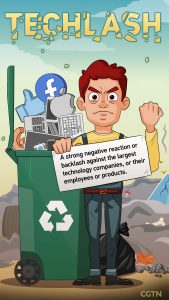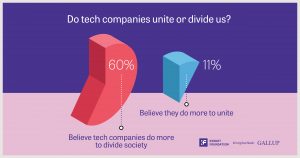Meaning of Techlash
Techlash means a strong negative reaction or backlash against the largest technology companies, or their employees or products. Some decades ago, big tech companies were seen as promoters of optimistic transformation. The internet had formed a worldwide stage for collective innovation (Neslage, 2020). On the other hand, social media had become a liberating force. Smartphones started transforming the lives of many people globally, and in 2010, techlash emerged. Researches refer to this concept as a widespread and strong negative response to technology firms’ growing influence and power.
Since World War II, technology has ensured the global economy and societies keep progressing. However, techlash has begun, and it is not expected to disappear any soon as opposition and fear of technology will continue.
In the 1980s, media coverage was favorable. However, things started changing in 2010, especially after the Arab Spring uprisings. Protesters used the internet to unify, organize, and spread their messages (Atkinson et al., 2019). Since then, technology started being seen as a liberating force.
In 2010, Mark Zuckerberg was named the male personality of the year for connecting individuals worldwide. He achieved this by creating a new system where people could exchange information. He altered the way humans were living. On the other hand, Spotify became a popular start-up that enabled users to stream and download songs for free. However, this positive shift in events has changed. More attention is currently focused on the negative effects of tech firms currently known as techlash. This includes threats to employment and environmental degradation (Atkinson et al., 2019). Today, the negative reaction towards large technology firms such as Facebook and IT entities is present.
According to research, techlash did not emerge suddenly. Few decades before IT transformed society positively, there were nuances on it being developed by specialists who promoted jeremiads. Some authors like Katherine Albrecht had started warning people against radio frequencies (Atkinson et al., 2019).
Techlash erupted due to several events, including the revelation that Russia had used the internet to interfere with the United States election of 2016. Cambridge had also misused Facebook’s information for political reasons while Google was being probed for antitrust violations (Mitroff & Storesund, 2020). After these events made news around the globe, people started spreading rumors that artificial intelligence was an evil product that posed a major threat to humans. Scholars added that AI had contributed to the loss of half of the jobs in the USA in two decades.
From the above scenarios, the initial excitement about IT started reducing as time progressed. Currently, many people believe technology is bad. Several activists are also fighting tech companies and making people think such firms are dangerous to the human race. The image below shows the meaning of techlash.

Source: news.cgtn.com/news/2020-12-29/New-words-from-2020-Techlash-WCe9kKrQqs/index.html
Public Concern that Lies Behind Techlash
https://itif.org/sites/default/files/2019-policymakers-guide-techlash.pdf

Source: knightfoundation.org/reports/techlash-americas-growing-concern-with-major-technology-companies/
As indicated in the image above, many people believe technology firms have divided people more than uniting them. This shows there is a huge public concern regarding IT. Various negative claims have also been made against technology companies on privacy and human well-being, promoting techlash (Marchant et al., 2020).
There are emerging public concerns about technology companies that lie behind techlash. For instance, people believe these firms facilitate the rise of surveillance capitalism. There are also rumors that the companies are destroying users’ privacy (Atkinson et al., 2019). Experts lament that technology firms provide billions of users with free services in exchange for access to their personal information.
Furthermore, activists believe online platforms are manipulating their consumers. They use business models and other methods to engage clients and convince them to spend money excessively. Besides, the companies are manipulating customers on behalf of advertisers instead of allowing them to connect with each other (Atkinson et al., 2019).
Another concern is that social media is affecting kids’ well-being. A 2012 study indicated that more than 50% of U.S. citizens owned a smartphone for the first time (Smith, 2020). This led to a great shift in the welfare of many Americans, especially the youth. The rate of this group’s suicide and depression cases increased. The level of happiness among teenagers also reduced significantly. Other studies have indicated that from 2012 to 2015, depression among boys and girls rose by 21% and 50%, respectively. Researchers state that this sudden increase was contributed by cyberbullying (Smith, 2020).
Furthermore, social media has been facilitating misinformation as it has become a platform for propaganda and manipulation (Atkinson et al., 2019). Technology is also changing people’s culture and behavior. Most young people today watch and read materials that contradict their values.
The Extent the Government can Address the Concerns that Lie Behind Techlash
To address privacy issues, the federal government, through parliament, should introduce rules on confidentiality. For example, in 2020, California implemented new laws on this subject matter (Marchant et al., 2020). More rules on cyberbullying should also be introduced and appropriate punishment established for those who harass people online. In addition, the government needs to introduce laws that promote advertising transparency to reduce customer exploitation.
The government must further regulate access to people’s information to strengthen internet users’ data privacy. Besides, lawmakers should take action on any technology company found violating confidentiality rules. Educating citizens on the violation of data privacy should also be prioritized. This will assist many people in realizing when the technology company is trying to take advantage of them (Marchant et al., 2020). Lastly, the U.S. government should adopt Europe’s GDPR that gives users the right to know the kind of information about them that is stored by technology companies and allowed to delete.
How Civil Society Organizations can Help Address Techlash Issues
Civil society organizations should facilitate the rise of activism against social media. They need to encourage people to unite and fight against techlash concerns such as data privacy (Atkinson et al., 2019). Through this, activists will attract the attention of technology companies which will work to solve the issues. The government will also be prompted to enforce laws that protect internet users.
Furthermore, civil society organizations must increase awareness of digital security vulnerabilities and threats. They should train technology users on the negative effects of using IT, such as cyberbullying. There is also a need to educate people on the personal information gathered by technology firms and how they can limit manipulation from such entities (Atkinson et al., 2019).
Civil society organizations should further educate the youth on how to report cases of cyberbullying (Atkinson et al., 2019). Moreover, they must establish mobile applications that protect young people from online abuse. For instance, France has a bodyguard app that acts as a real-time moderator. The app detects toxic comments even in the form of emojis or typos. It then deletes them automatically before the user reads them. Such apps will assist in adjusting the level of youth protection against threats, insults, or racial slurs. To improve security for kids, the application should notify parents through their email about the comments their young ones have received, especially from social media. Below is an image showcasing an example of activism campaigns.
An Extinction Rebellion environmental activist mother group protest outside Google UK HQ demanding they stop climate deniers profiting on their platforms on October 16, 2019 in London, England.
Source: www.theverge.com/2021/9/16/22677376/facebook-climate-change-misinformation-fossil-fuel-advertising.
The Extent Technology Companies Can Address the Concerns that Lie Behind Techlash
Large tech companies should use technology to prevent issues such as cyberbullying. For example, their apps should have artificial intelligence settings that allow users to automatically hide and filter threats or racist comments intended to upset or harass them (The economist, 2018). Additionally, technology companies should encourage positive interaction and behavior by giving users a tool to customize their experiences on social media. For instance, they can utilize Restrict, which empowers customers and protects their accounts while monitoring bullies. Organizations should further adopt policies and procedures related to digital security.
In conclusion, people used to view technology as a solution to most of their current and future issues. However, the rise of techlash has empowered individuals who now criticize the internet and social networks. Activists believe IT has increased the rate of deaths among teenagers due to cyberbullying. Therefore, tech companies must introduce tools that protect their clients, especially from harassment, to avoid such issues. Failure to safeguard user data might lead to conflicts with customers and even trigger lawsuits which might further contribute to losses in terms of compensations. The government also needs to play its oversight role in ensuring such companies protect citizens’ information. The firms must be banned from selling people’s data to third parties without user consent.
References
Atkinson, R. D., Brake, D., Castro, D., Cunliff, C., Kennedy, J., McLaughlin, M., & New, J. (2019). A policymaker’s guide to the “techlash”—what it is and why it’s a threat to growth and progress. Information Technology and Innovation Foundation. https://itif.org/sites/default/files/2019-policymakers-guide-techlash.pdf
Marchant, G., Tournas, L., & Gutierrez, C. I. (2020). Governing Emerging Technologies Through Soft Law: Lessons for Artificial Intelligence. Jurimetrics, 61. https://lsi.asulaw.org/softlaw/wp-content/uploads/sites/7/2021/04/01-18-gets-through-soft-law-special-issue-intro.pdf
Message, K., 2020. Techlash? America’s Growing Concern with Major Technology Companies.https://knightfoundation.org/reports/techlash-americas-growing-concern-with-major-technology-companies/
Mitroff, I. I., & Storesund, R. (2020). Techlash: the future of the socially responsible tech organization (p. 55). Springer Nature. https://library.oapen.org/bitstream/handle/20.500.12657/37366/978-3-030-43279-9.pdf?sequence=1
Smith, M. (2020). Review of Neil Selwyn, Felicitas Macgilchrist, and Ben Williamson (2020). Digital Education after COVID-19. TECHLASH, 1. Postdigital Science and Education, 1-5. https://link.springer.com/article/10.1007/s42438-020-00184-7
The economist, 2018. The techlash against Amazon, Facebook, and Google—and what they can do. https://www.economist.com/briefing/2018/01/20/the-techlash-against-amazon-facebook-and-google-and-what-they-can-do
